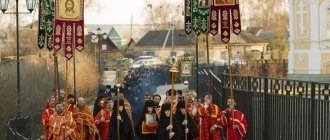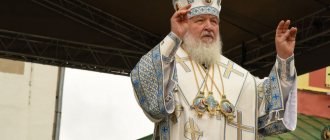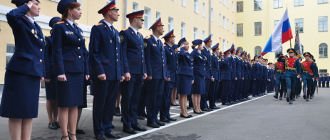History of the procession
Once, in 1383, on the banks of the Velikaya River, St. Nicholas the Wonderworker appeared in person to a peasant named Agalakov and gave him his image. The icon was kept by the peasant and his fellow villagers came to pray to it, and soon they began to testify to the miracles that happened through prayers to the icon.
Read about the saint:
- Prayer to Nikolai Ugodnik for help with money
- Prayer to Nicholas the Wonderworker for his son
- Prayer to Nicholas the Wonderworker for his daughter
The miraculous Velikoretsk image of St. Nicholas
News of the beautiful image spread quickly and soon pilgrims began to flock from all over the region to venerate and pray to the miraculous image. Local peasants, using their own funds, built a small chapel on the spot where the icon appeared, and later erected a temple.
The beginning of the religious procession
In the 14th century, the Vyatka land was inhabited mainly by pagans who worshiped the forces of nature. Russian people had just begun to settle here, and this led to worries about the holy image - the pagans disdained the Russian shrines and conflicts often occurred on this basis, followed by the derogation of icons. These fears in 1392 became the reason for the transfer of the image from the village to Khlynov (currently the city of Kirov).
But the city residents promised the peasants that they would bring the image back every year. This was the beginning of the Velikoretsk religious procession.
The Velikoretsk religious procession is held every year from June 3 to June 8
Miracles and signs continued to accompany the image of St. Nicholas, and his fame spread throughout the Russian Empire. In the 16th century, Ivan IV heard about it, and at his request the icon was transported to Moscow. On the Khlynov-Moscow road, many bowed and prayed to the icon, and later testified to the healing. One of the chapels of the Moscow St. Basil's Cathedral was consecrated in a miraculous way. During his entire stay in the capital, several copies were written from the icon.
Since the 16th century, Russia began to venerate the miraculous image of Velikoretsk Saint Nicholas and continues to this day. Later, already in the 17th century, the image again visited the capital.
God-fighting time and the resumption of the religious procession
In the 16th-20th centuries, the Velikoretsky image was kept in Vyatka and it was from here that the religious procession began every year, but with the advent of Soviet power, the cathedral was destroyed and the image was lost. During the USSR, pilgrimage was prohibited (from 1930 to 1990) by the authorities, and in 1959 the ban was imposed by the atheistic authorities. However, unofficially, people continued to make this journey from the cathedral to the Velikaya River, without an icon and without the official accompaniment of Orthodox ministers. The desire to make this journey and thus take part in the movement of the church moved people along this path.
The journey was resumed in 1989 thanks to the efforts of Archbishop Chrysanthos.
Important! In 2000, according to the decree of the patriarch, the religious procession became an All-Russian procession.
During Soviet times
After the decree of the Council of People's Commissars “On the separation of church from state and school from church” was issued at the beginning of 1918, persecution began against the cross-walkers. In the 1920s, the Trinity Cathedral, where the icon was kept, fell into the hands of renovationists, and in 1935 it was blown up. The image disappeared without a trace. But the religious procession continued, despite the prohibitions. People walked and carried icons of St. Nicholas the Wonderworker. Many were subjected to repression. But even then people set off on this “secret journey,” as this procession was popularly called. And over time, the authorities began to turn a blind eye to the “disgrace that was being committed.” In 1959, the religious procession was officially banned. Pilgrims were caught and beaten with batons. But in April 1978, Bishop Chrysanthus of Vyatka and Sloboda, the religious procession was recreated in its former glory. The city of Slobodskaya is also famous for the fact that 100 years ago, many miraculous healings occurred from the icon of the Mother of God “Consolation in Sorrows and Sorrows” brought here from the Holy Mountain. In gratitude, Slobodsk residents made bells for the Russian St. Andrew's Skete. The events of August 1991 made it possible to revive the ancient Orthodox tradition of the Russian people. If in the year of the 1000th anniversary of the baptism of Rus' it was allowed to walk only seven miles from the village of Chudinovo to Velikoretsky, then since 1992 the Velikoretsky religious procession has followed its own historical path. The doors smoothly swing open and a church procession floats out into the street. The gilded vestments of the priests flash on and off. Echoing them, golden crosses, banner poles, and icon frames sparkle and shimmer. The gilded bulbs of the domes beg the sky for their last favors. The procession resembles a huge river, carrying its waters into the stormy sea of life. The ever-increasing ringing of bells - a scattering of sounds scattered from the bell tower by the generous hand of bell ringers - sees off a crowd of thousands with candles in their hands. Resembling a huge cluster of fireflies, it smoothly spreads, mincing behind the shepherds.
Description
The Velikoretsk religious procession has been held for more than 600 years. At one time it was even carried out along the Vyatka and Velikaya rivers, along which boats and rafts moved. But later, due to the constant increase in those wishing to take part in the movement, they began to move again by land.
The Velikoretsk religious procession gathers a huge number of pilgrims
This event is large-scale, but clear and takes place according to a drawn up and pre-approved schedule. This is necessary for control and measured conduct of the event in order to avoid unforeseen circumstances and chaos.
- Sunday, June 3, begins with morning liturgy (7 a.m.) in the Kirov Cathedral, conducted by Metropolitan Mark. Services continue in front of the Holy Dormition Monastery at 9 am and within an hour people move to the Trinity Church. There, everyone joins the movement and the movement leaves the city. The day ends in the village of Bobino, where they perform a prayer service and stay overnight.
- On Monday, June 4, the rise is early - pilgrims get up at 3 am and leave Bobino and already at 10 am they perform a prayer service in the village of Zagarye. Traffic resumes only at 12 noon and lasts until 8 pm, when everyone reaches the village of Monastyrskoye and spends the night there after a prayer service.
- Tuesday, June 5, begins just as early - at 3 am the pilgrims already leave the village and 6 hours later they arrive in the village of Gorokhovo, where they take part in the solemn service. After a short break at noon, people leave the village. At the same time, buses with those wishing to take part in the service on the Velikaya River begin to depart from Kirov from the St. Seraphim Cathedral. At 6 pm, both walking pilgrims and those who arrived by transport meet at the Velikoretsky Compound. Already at 6.30 pm three night services begin: on the river and in the Preobrazhensky and Nikolsky churches. All vigils involve the sacrament of confession.
Solemn divine service in the village of Velikoretskoye on the Velikaya River
- Services begin at 1 a.m. on Wednesday. First, the liturgy is in the Transfiguration Church, two hours later in the St. Nicholas Church and at 6 am it begins on the shore. Buses also depart from Kirov to Velikoretskoye. Those who want to visit the holy spring near Velikoretsky do so at lunchtime, at which time the water on the river is blessed. The image of St. Nicholas is transferred to the St. Nicholas Church at 2 o'clock in the afternoon and prayer services are held there until 6. In the evening, buses take those interested to the city.
- On Thursday, June 7, pilgrims leave Velikoretskoye at 2 a.m. and walk until 2 p.m. A break and rest along with a prayer service is carried out in the village of Medyany. From 17.00 to 19.00 people go to the village of Murygino, where they spend the night.
- Friday June 8th is the final day of the procession. People leave Medyan at 3 am and later participate in a prayer service in neighboring Girsovo. At 16.30, pilgrims reach the Holy Assumption Cathedral and listen to the final prayer service. At 18.00 the procession ends.
Attention!
If pilgrims, for health reasons, cannot walk the entire route, they can use the services of buses that take and bring Orthodox Christians to the site of Divine Liturgies. At each stop, pilgrims can receive a portion of hot water and food, as well as the opportunity to rest and recuperate.
Sacrifice to God
On the 600th anniversary of the discovery of the miraculous image, the Velikoretsk religious procession was given the status of an all-Russian procession. At first, no more than 200 crusaders gathered, and even fewer returned. We walked not with the icon of St. Nicholas the Great, but with the cross from the Trinity Church in the village of Makarye, then with the cross from the Church of St. Seraphim of Sarov, and only since 1996 - with the icon. The number of crosswalkers increases every year. The Velikoretsk religious procession has become so firmly established in the lives of many of them that they come here as families. Nowhere do they pray so desperately as at the Velikoretsk religious procession. For six days, it’s as if you find yourself in another world: the Orthodox army marches, glorifies Christ and St. Nicholas the Wonderworker, prays for Russia and for the salvation of the soul. There are no easy religious processions. The tests begin from the very first steps. The scorching sun melting the asphalt; heavy rain turning roads into impassable abysses; morning frosts, or even snow - the army of Christ doesn’t care about anything. They say that the oldest of the participants in the religious procession was over 90, and the youngest was nine months old. Patriarch Kirill of Moscow and All Rus', addressing the participants in the Velikoretsk religious procession, noted that when believers stand in the church at a service for 2-3 hours, sometimes longer, giving him physical strength and time, then this is at least a small sacrifice to God. Thanks to such processions as Velikoretsky, our Fatherland still remains one of the islands of spirituality on planet Earth. Russia is the foot of the Throne of the Lord. As long as it exists on the world map as a sovereign Orthodox state, the true faith - Orthodoxy - will not dry up.
Magazine: Mysteries of History No. 7, February 2021 Category: Religions of the World Author: Maria Kosorukova
Tags: Mysteries of history, church, Orthodoxy, pilgrimage, village, icon, Nicholas the Wonderworker, Kirov, religious procession, Velikoretskoye
- Back
- Forward
Tradition that survived the revolution
For centuries, throughout their 150-kilometer journey from Vyatka to the village of Velikoretskoye and back, pilgrims performed prayer services in the parish churches of ancient villages: Makarye, Zagarye, Bobino, Gorokhovo, Monastyrskoye, Fileyskoye and Medyany. As soon as the banners appeared in the distance, followed by the endless stream of the Velikoretsk religious procession, the ringing of the bells of the village churches was heard throughout the area.
In the first post-revolutionary years, the tradition that had developed over the past centuries was steadily observed, despite all the opposition of the new government. As in former times, thousands of pilgrims of the Velikoretsk religious procession gathered on the appointed day on the Cathedral Square in the city of Vyatka and from there began their five-day journey.
Revival of an ancient custom
With the advent of perestroika and changes in state policy towards the church, the ridiculous decree of 1959 was canceled, but over the next four years the route of the Velikoretsk religious procession was significantly shortened and, starting from the village of Chudinova, was only 10 km. Only since 1993 did its participants have the opportunity to cover all 150 kilometers separating the city of Kirov from the place where the icon was found on the Velikaya River within five days.
Meanwhile, it was not possible to fully revive the tradition of past centuries, since all the temples near which pilgrims once stopped and performed prayer services were destroyed or were in disrepair. There was still a long period of their revival ahead. It was then that it became customary to perform liturgies right in the field or on the river bank, using camp churches for this. This form of worship is still widely practiced today.
Other Kursk news for this day
July 2, 2021, 11:30 pmIn the Kursk region, police and prosecutors are checking information about the “slavery” of Ukrainian citizens | July 2, 2021, 10:34 pmA minibus and a car collided in the center of Kursk |
2 July 2021, 20:45A Serbian citizen accused of a fatal accident was taken into custody in Kursk | July 2, 2021, 20:00Avangard Kursk signed a Lokomotiv player |
2 July 2021, 19:35A bus got into an accident near Kursk | 2 July 2021, 18:40In 9 houses on the street. On the 50th anniversary of October in Kursk, hot water was turned off until September 15 |
2 July 2021, 17:52In Kursk, residents of Nizhnyaya Naberezhnaya street are trying to save houses from flooding | 2 July 2021, 17:39Falling trees damaged several cars in Kursk |
2 July 2021, 17:00What kind of weather is expected in the Kursk region this weekend? | 2 July 2021, 16:30Near Kursk, two men hit a man with a car, kidnapped him and buried him in a field. |
2 July 2021, 16:00In Kursk, traffic is blocked on some streets | 2 July 2021, 15:45In Kursk, after a rainstorm, 44 people clean storm drains |
2 July 2021, 15:19In Kursk, a car fell into a hole due to collapsed asphalt | 2 July 2021, 15:00Gyms are being renovated in 10 schools in the Kursk region |
2 July 2021, 14:56A resident of Kursk got into a fight with a policeman in a bathhouse | 2 July 2021, 14:52Kursk residents saved more than 12 million rubles when paying for travel with a MIR card |
2 July 2021, 14:32A man and a woman were injured in a serious accident near Kursk | 2 July 2021, 13:51In the Kursk region in 2022, the number of flight hours of air ambulance helicopters will increase to 400 |
2 July 2021, 13:47Rain in Kursk flooded the streets | July 2, 2021, 12:38 pmA boyfriend from a dating site robbed a resident of Kursk |
2 July 2021, 12:30Showers with thunderstorms and hail are expected in the Kursk region | 2 July 2021, 12:21A car overturned near Kursk |
2 July 2021, 12:02The exhibition “The Variety of the Russian Shawl” opened at the Kursk Museum of Archeology | July 2, 2021, 11:30Kursk table hockey player Denis Matveev tops the world rankings |
2 July 2021, 11:18A 4-year-old boy rescued from a swimming pool on the roof of a shopping center in Kursk was flown by helicopter to Moscow | 2 July 2021, 11:12Mayor of Fatezh Evgeny Lobov appointed director of the internal policy department of the Kursk region |
2 July 2021, 10:58Putin signed a decree on the payment of 10 thousand rubles to families with children | July 2, 2021, 10:56 amThree more people died from coronavirus in the Kursk region |
2 July 2021, 10:53In the Kursk region, 143 cases of coronavirus were registered per day | July 2, 2021, 10:42 amIn Zheleznogorsk, Kursk region, a car hit an 11-year-old cyclist |
July 2, 2021, 10:21 amAvangard Kursk played a draw with Salyut in Belgorod | 2 July 2021, 10:15There are yet another personnel changes in the administration of the Kursk region |
July 2, 2021, 10:00A girl driver was injured in an accident in Kursk on Engels | 2 July 2021, 09:42Kursk gas workers identified 18 cases of illegal connection to networks |
2 July 2021, 09:309 million were taken away from a resident of Kursk through extortion and violence | 2 July 2021, 09:15 |
The birth of new traditions
It is interesting to note that in post-perestroika times a whole series of new traditions of the Velikoretsk religious procession developed (Kirov ─ the village of Velikoretskoye on the banks of the Velikaya River). One of them is that many pilgrims, having arrived at the place, plunge into the waters of the forest spring, near which the miraculous icon was found by Semyon Agalakov.
In addition, in the villages of Murygino and Medyany, located along the route of the procession, it became a custom to greet the procession with the whole world, young and old. At the same time, older people kneel down and, crossing themselves, bow to the image of St. Nicholas the Wonderworker, while young people, holding hands and lining up in a chain, pass under the icon, receiving the blessing of the Myra saint.
Wonderful light in the forest thicket
The history of the Velikoretsk religious procession dates back to the 15th century, and it is connected with one very extraordinary event. As a church tradition that has existed on the Vyatka land for more than six centuries tells, a pious peasant from the village of Krutitsa Semyon Agalakov, once passing along the wooded bank of the Velikaya River, was struck by the sight that opened before him: a little to the side, from a thicket of trees, a mysterious light emanated, as if there was a fire burning there. a hundred candles. Frightened at the sight of such a miracle, the peasant made the sign of the cross and hurried on.
On his way back, he was again stopped by luminous rays emanating from the forest darkness. This time Semyon overcame his fear and, saying a prayer, went deeper into the thicket. Imagine his amazement when, parting the branches of the trees, he saw a spring gushing from the ground, and next to it - a source of wondrous light, which turned out to be the image of St. Nicholas the Wonderworker.
Transfer of the miraculous icon to the city of Khlynov
With great reverence, Semyon Agalakov picked up his find from the ground and, bringing it to the village, handed it over to the rector of the local church. Further, the legend reports that soon after finding the icon, the Lord began to show people through it wondrous miracles of healing, rumors of which quickly spread throughout the area.
This event took place in 1383, and a few years later, by the decision of the diocesan leadership, the miraculous image was transferred to the city of Khlynov, which at that time was the capital of the Vyatka region. The reason for this was the widespread veneration of the newfound image and the impossibility of accommodating the ever-increasing number of pilgrims in the village. However, the residents of Khlynov made a promise to annually return the priceless relic to the place where it was found. This is how the people’s tradition of performing the Velikoretsk religious procession was born once a year.
Feedback from participants
The statements of those who found it necessary to share their impressions of participating in the five-day procession to the banks of the Velikaya River on the pages of Internet sites are also worthy of attention. Many, in whose words one senses an extraordinary emotional upsurge caused by the events they experienced, write about how they were indelibly impressed by the faith of thousands of people driven by a common religious impulse.
Everyone is struck by the extraordinary spiritual unity of the diverse people who took part in the procession. After all, among them, according to the participants in the move, there are young and old, healthy and sick, those whose appearance indicates that they belong to a wealthy category of citizens, and those who clearly found themselves left behind in life.
Every year in mid-June, many reviews from pilgrims appear on the Internet and on the pages of printed Orthodox publications. Each of them shares their impressions and describes the excitement they experienced in their own way. But in all messages, as a rule, a common thread runs through the general idea that the Velikoretsk religious procession is “one of the wonders of the Russian land.” And you can fully experience this only by walking with your own feet the 150-kilometer path leading to the spring of the true Orthodox faith.









